
Our Sun is one of the million other stars located on the edge of the spiral arms of the Milkyway galaxy. Our star is a main sequence dwarf that belongs to the G2 spectral class in the H-R diagram. Ejnar Hertzsprung and Henry Norris Russell first developed H-R diagram in 1913. The first H-R diagram plots the spectral class versus stars' absolute magnitude.
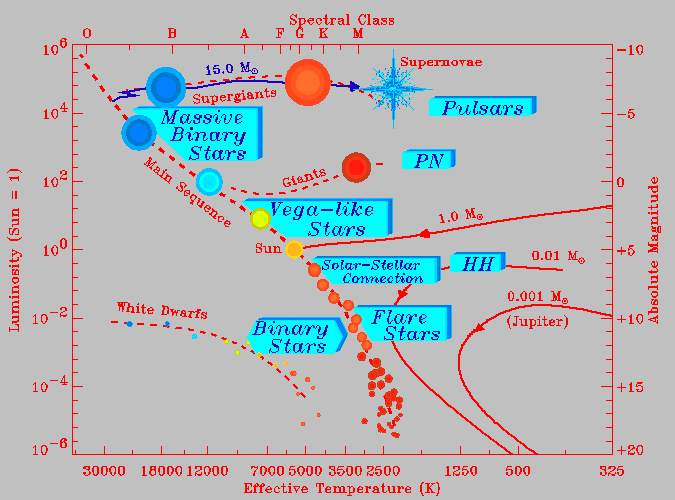
It weighs about 2x1020 kg with a density of 1.4x103 kg/m3. It has a diameter of 7.105 km and a surface temperature of 6,000K. The Sun consists of mainly Hydrogen (H) and Helium (He) with very little heavy elements. As we shall see later the importance of these characteristics to the evolution of life on Earth.
Our nine planets are categorized into two types. The four inner planets (Mercury, Venus, Earth, and Mars) are called Terrestrial Planets for obvious reasons. Their rocky structure and a solid inner core give us this name. The densities of these planets are close to that of Earth. Now we know that all of the four planets have an atmosphere above their rocky surface. This includes Mercury.

Meanwhile the outer five gas giants are (Jupiter, Saturn, Neptune, Uranus and Pluto) are called "Jovian Planets". Their composition resemble closely to that of the Sun, consisting of H, He, CO, CO2, CH4 (methane) and HN3 (ammonia). Due to their structure and their composition some have suggested that Jupiter might be a failed star. But this would not apply to other gaseous giants. Their size and structure and the angular spin correspond more to planet than a failed star. The only exception to this is the planet Pluto. Pluto resembles a Terrestrial planets in its size and make. This small planet is an oddity among the gaseous giants.
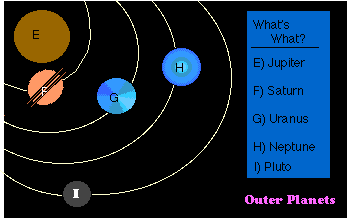
Laplace theoryLaplace theory
In the early stages of the Sun, it was surrounded by a cloud of nebula. This was the leftover matter from the formation of the Sun. It should be noted that this nebula spun in the same direction as the spin of the Sun. It is from this cloud of remaining star matter that the planets were formed.
The great French astronomer-mathematician Pierre S. Laplace (1749-1827) theorized that this cloud of nebula was responsible for the formation of planets. He envisioned a time when our young star is engulfed in a cloud of nebula. As the star condensed, the gravitational force of the Sun increased. Now if the nebula cloud had a rotation, its angular velocity would increase as it contracts. He theorized that because of this acceleration this nebula would flatten into a shape of a disc. He decided that the rotation of the nebula would be so fast that it would became unstable and a release a ring of nebula to relieve the strain. But again as our Sun contracts, the angular momentum would increase making it unstable and thus releasing another ring. It would do this until the Sun become stable.
Each of these rings the Sun spewed out would coalesce to form another body, "proto-planet". These condensed proto-planets would go through the same process as the Sun. But since the weights of these proto-planets are not as massive as the Sun, their gravitational force would not ignite under fussion. Depending on the size, gravitational pull and the angular velocity, these proto-planets would turn into Terrestrial or Jovian planets.
Bode's Law
Johann Titius in 1772 attempted to explain the distance of the planets from the Sun. This law was later publicized by Johann Bode. For a long time it was known by his name alone. It is recently that the law is known as "Titius-Bodes law". Bode's law can be expressed as,
Orbit size = [3N+4]/10 AU where N=0,1,2,4,8,16,32
| Planet | Distance from Sun (AU) | Bode's Law |
| Mercury | 0.387 | (0+4)/10=0.4 |
| Venus | 0.723 | (3+4)/10=0.7 |
| Earth | 1.0 | (6+4)/10=1.0 |
| Mars | 1.524 | (12+4)/10=1.6 |
| Asteroid Belt | 2.77 | (24+4)/10=2.8 |
| Jupiter | 5.203 | (58+4)/10=5.2 | Saturn | 9.539 | (96+4)/10=10.0 |
| Uranus | 19.18 | (192+4)/10=19.6 |
| Neptune | 30.06 | (384+4)/10=38.8 |
| Pluto | 39.44 | (768+4)/10=77.2 |
For centuries many believed that our solar system consisted of seven bodies, Sun, Moon, Mercury, Venus, Mars, Jupiter and Saturn. Earth was not included since hey believed in a geocentric concept. This idea of a geocentric concept and a flat Earth theory were based on Greek and Roman traditions. That was till Nicolaus Copernicus published his “De revolutionibus Orbium coelestum” in 1543. He envisioned a Heliocentric system with the Sun at the center. Yet 2,000 years before him Greek astronomer Hipparchus and Eudoxus who lived in Asia Minor suggested a heliocentric system. They also pointed out that Earth is round and not flat. Studies shows that these scholars burrowed these knowledge from even an older Akkadian, Hittite and Babylonian. Their knowledge was derived from yet even older Sumerians.
The Old Testament, which is full of astronomical facts, points out that the Earth was spherical and not flat. Joseph compared himself and his brothers to the twelve celestial bodies in heaven. Meanwhile Jacob blessed his 12 descendants by associating them with the 12 constellations of the Zodiac.
There are two things evident from this. First it is obvious that the ancient Sumerians knew the exact number of planets and satellites and celestial positions. Second the ancient Sumerians, Egyptians and Babylonians had knowledge of advanced astronomy, mathematics, biology and other technology that was somehow lost to the later civilizations.
An Akkadian seal from the 3rd millennium BC at State Museum in East Berlin show a representation of our solar system as know to the Sumerians.
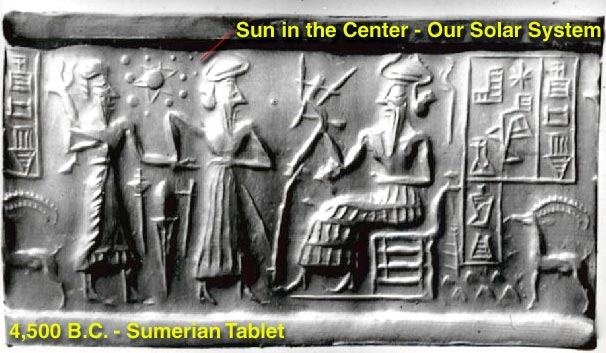
4,500 years old Sumerian seal account for all the known planets and their exact position and size except for the position of Pluto and an unknown planet between Mar and Jupiter.
Moon is another planet
It is apparent that Sumerians and other ancient Near Eastern civilizations regard moon as a separate celestial body in its own right. This advanced Sumerian civilization was able to calculate the rise of the polar star, vernal equinox, and possessed engineering technology to build complex pyramids. They also knew that there were planets beyond Mars and Jupiter. Was Sumerians wrong in their classification of the Moon?
Long held theory was that Moon was a chuck that was torn off the Earth when Earth was still in its molten plastic state. This theory was disproved after successful Apollo Moon missions. Analysis of rocks brought back by the Apollo astronauts established that though presently barren it was once a "living" planet. Chemical and mineral composition of these rocks were also different disproving that the Moon was once a part of the Earth.
Like Earth Moon is also layered indicating that it solidified on its own from a molten state. Just like Earth, the Moon also radiate heat. Unlike Earth which radiates heat from radioactive material under pressure at the Core; the Moon radiates heat from radioactive materials lying near the surface.
Apollo 16 discovered rocks that were shattered and then re-welded together by extreme and sudden heat. Apollo 15 also discovered landslides that were size times greater than any on Earth. Apollo 16 found debris 1000 miles around the crater sea of Nectar implying that a tremendous collision with an asteroid had created it.
Another bit of evidence to disprove the old theory came about when we learned of the Moon's specific gravity, 3.33g/cm3 compared to that of Earth's 5.5g/cm3. This bit of information alone is enough to dispel the theories that the Moon is chuck of Earth or was formed along side Earth.
Lunar rocks brought back indicated that on average they were about the same age. Yet there were few that were about 0.5 billion years older than the oldest rocks on Earth. This indicates that the Moon could not have formed at the same time as Earth.
These and other information proved that Sumerians were right when they considered Moon a celestial body in its own right. Therefore Moon was not once a part of the Earth and nor it a satellite of Earth.
Epic of Creation
Recently many researchers have shown hat some of the accounts in the Bible are plagiarism of an older Mesopotamian text. In the ruins of library of Ashurbanipal in Nineveh, Henry Layard uncovered evidence to indicate that there was a tale of creation told similar to the book of Genesis. The old Akkadian text was written in old Babylonian dialect relates how and deity created heaven and earth, including man.
Babylonian deity’s work was done in six tablets while the biblical GOD completed his work in six day and rested on the seventh. Babylonian seventh tablet devotes to exaltation of this deity and his achievements. These seven tablets were translated and named “The seven tablets of creation” by L. W. King. This is now popularly called the “The epic of creation”. It tells us a story of war between gods and a struggle between good and evil. Scholars believe that this story is a duplicate from the Sumerian era. Most scholars relate the story as an allegorical tale of nature or a philosophical work. But it makes more sense to take it at its face value at nothing more than a set of cosmological events or facts known to the Sumerians.
In the first few lines of the first tablet, the story tells of the formation of “primordial AP.SU” (“one who exists from the beginning”); and MUM.MU (“one who was born”); and TIAMAT (“maiden of life”). APSU then becomes the Sun, “one who exists from the beginning”. Meanwhile MUMMU was the trusted aide and emissary of APSU. A very good description of planet Mercury. A small planet rapidly running around it’s giant master. The ancient Greeks and Romans named Mercury : the fast messenger of gods”. Further away was TIAMAT, a monstrous planet.
Between MUMMU and TIAMAT two more planets were formed. “Gor LAHMU and god LAHAMU were brought forth”. LAHMU and LAHAMU refer to male and female deities respectively. LHM translated “to make war” grant us that LAHMU refer to Mars. Then LAHAMU refer only to Venus, goddess of love.
We are told that Mars and Venus grew only to a limited size. Then another pair of planets were created, AN.SHAR (“prince foremost of the heavens”) and KI.SHAR (“foremost of the firm lands”). These two planets were huge and from the location we identify them as Saturn and Jupiter.
A third pair of planets were brought forth. ANSU and NUDIMMUD/EA clearly represent Uranus and Neptune. But the Sumerians do not place Pluto beyond Neptune as we know it today. The “epic of creation” refers to ANSHAR/Saturn as having produced an offspring. This offspring GAGA, a celestial deity sent out as an emissary on various missions by Saturn. Similarities between Mercury and Pluto are remarkable. This explains Pluto’s size and it’s erratic orbit.
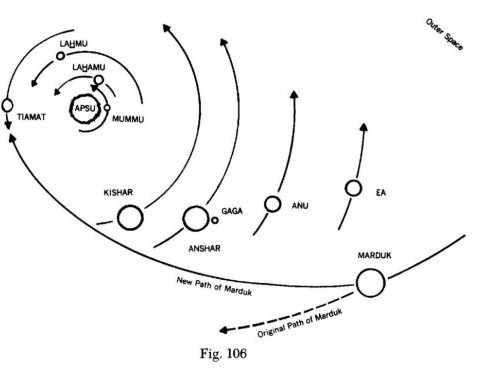
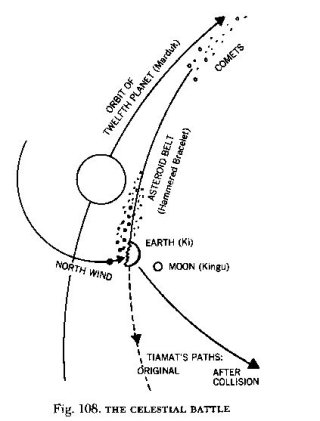

Next it goes on to tell how the gravitational forces of each planets and Sun effect an erratic and unstable planetary orbits. This would be an accurate scientific description of our solar system at the beginning. It even points out that Sun/APSU was helpless in containing these deities. The Sun would be able to exert a certain stability to the closer planets by its gravitational pull. But this gravitational force would have an effect on further planets such as Saturn, Jupiter, Uranus or Neptune.
The story now points out that after a period of time, a calming effect “pouring of sleep” came upon them. This again is scientifically sound. As the planets become stable and their planetary orbits become defines, the gravitational un-stability experienced at the beginning would cease.
Act III or tablet3, now goes on to say that another celestial god or a new planet is born deep in space. The story now centers around this new planet, MARDUK. At first MARDUK is attracted towards our solar system by the Sun and the combine gravitational forces of the nine planets. But as MRDUK approaches our solar system EA/Neptune pulls her in yet closer to it’s gravitational force. As MARDUK passed by EA, it begot another head. This indicate this planet was still in it’s plastic stage and due to the gravitational force of Neptune caused a bulge on one side. But as it approached ANU/Uranus, the second head separated and became a “swirling as a whirlwind”. This could only mean that due to the gravitational forces of Uranus this bulge separated from MARDUK and became four different satellite.
As MARDUK approached the giant ANSHAR/Saturn and KISHAR/Jupiter, the planet is pulled further into a more elliptical path. From the order of passage, first passing Neptune, then Uranus and then Saturn and Jupiter, we can conclude that MARDUK is entering our solar system in a counter-clockwise direction. Keep in mind that all the planets in our solar system moves in a clockwise direction.
As the giant planet MARDUK intruded further into our solar system APSU/Sun is again “waken from its sleep”. Due to the gravitational attraction between APSU/Sun and MARDUK, APSU creates another planet between TIAMAT and KISHAR/Jupiter. It formed from the nebula matter between the vast spaces of Jupiter and TIAMAT coalesced into another planet. To maintain the gravitational stability of APSU/Sun and the rest of the planet, this new and smaller god, KINGU, is located closer to TIAMAT. It is at this moment that eleven smaller satellites “monsters” emerged around TIAMAT.
But this gravitational stability is short lived as MARDUK approached ANSHAR/Saturn. At this point the gravitational pull of MARDUK was strong enough to pull GAGA away from ANSHAR/Saturn’s gravitational force. Once GAGA became free from Saturn’s ring, it was captured and becomes another satellite of MARDUK.
Tablet IV relates the rest of the battle between MARDUK and TIAMAT. Approaching KISHAR/Jupiter, MRADUK is pulled yet further into our solar system by it’s huge gravitational force. Subjected to the tremendous gravitational force of Saturn and Jupiter, three more satellites around MARDUK was created.
As MARDUK approached closer to APSU and TIAMAT gravitational equilibrium was unbalanced. To counter this, TIAMAT moved into a slightly bigger orbit and captured KINGU as it’s own satellite. But this did not alter MARDUK’s new orbit, which is destined to cross TIAMAT. In the Sumerian text MARDUK and TIAMAT actually never collides with one another, at least not on the first encounter. It was the satellites of MARDUK that smashed and collides with the eleven “monsters” or satellites of TIAMAT. The story tells us that due to the force of the impact shattered remains of TIAMAT’s and MARDUK’s satellites “marched at her side, gods helpers”. This could only mean that the shattered pieces moved along side of MARDUK captured by its gravitational force. This solves another mystery in our solar system, Comets. It can be attained that the small pieces retained MARDUK’s orbit and later escaped its gravitational force to become comets. This explain comets, their origin, retrograde orbital motion and the orbital path.
After MARDUK has left our solar system an equilibrium among the planets is regained. And KINGU becomes a permanent satellite around TIAMAT. As most comets and migrating planets, which MARDUK is one of them, its orbital path brings him back to the “scene of the fight” or our solar system .
On the 4th tablet “the epic f creation” describe the creation of earth and heaven. It is at this point that we find a similarity in the story and the words used between the Sumerian “epic of creation” and the book of Genesis in the Bible.
The lord paused to view her lifeless body. To divide the monster he then artfully planned Then, as a mussel, he split her into two parts.
. This passage is almost self-explanatory. On the its second orbit MARDU collides with TIAMAT, splitting her in half. Then one of remaining satellites of MARDUK, one called “North Wind”, crash into the separated half. The blow was heavy enough to push this half into an orbit closer to the Sun. Earth had been created. This half along with it satellite KINGU, our moon, moves into the present day orbit of Earth.
Meanwhile the other half is completely shattered into pieces. They are stretched out into a “great band” or “bracelet”. Thus the asteroid belt is created. Sumerian text explains two mysteries about the asteroid belt. We know from scientific fact that the asteroid belt is not the result of a failed planet as some have suggested. We also know that the combine mass of all asteroids in this belt is not enough to account for a planet. We have shown the reason behind the existence of the asteroid belt and the its total mass.
This theory explain not only the asteroid belt but also the unusual elliptical path of Pluto, formation and orbit of the comets; and the existence of a giant satellite, Moon. Can this theory also explain why Earth’s continents are concentrated on one side and a deep cavity (Pacific Ocean bed) on the opposite side? When MARDUK’s satellite, “North Wind”, struck TIAMAT it created the deep cavity, the Pacific Ocean. Due to the force of the blow mountains and hills were forced upwards on the opposite side of the Earth.
